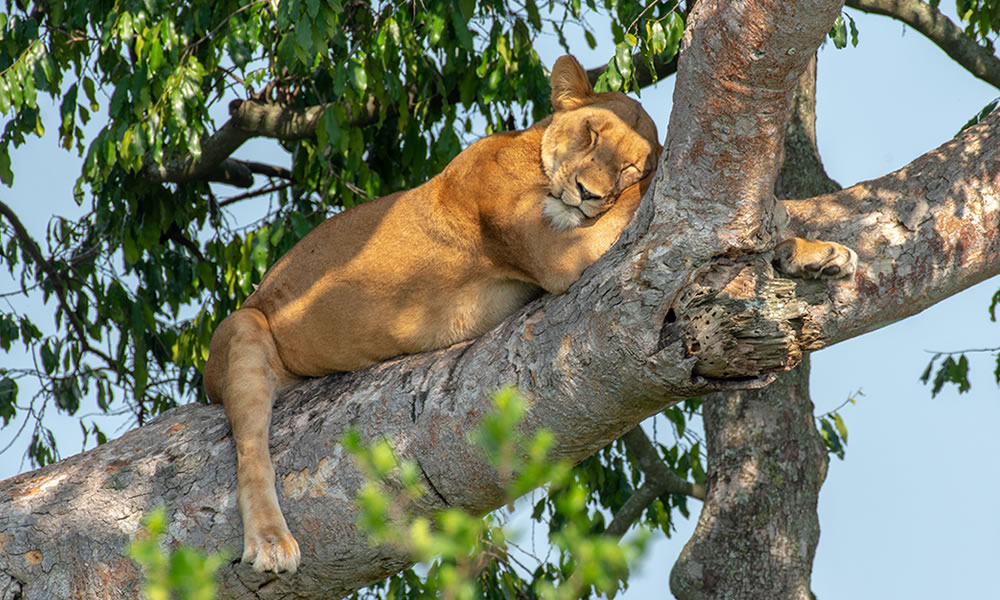Located near the Rwenzori mountain in the Kasese area of western Uganda, Queen Elizabeth National Park is one of the most popular and frequently visited parks in the country. Originally known as Kazinga National Park, Queen Elizabeth National Park is a magnificent park that was named after the Queen of England in 1952. One of the most visited tourist places in Uganda is Queen Elizabeth National Park, which spans 1978 km and is the country’s second-largest park. It is flanked by several districts, including Kamwenge, Kasese, Mbilizi, and others. Numerous animal and bird species can be found in Queen Elizabeth National Park, such as the intriguing Ishasha tree-climbing lions. The park, which is about 400 kilometers or about six hours’ drive from Kampala is well-known for its abundance of wildlife, several stunning crater lakes that wind through undulating hills, and the expansive Kazinga Channel, which offers a breathtaking view of hippos, buffaloes, elephants, and a variety of bird species lining the shores. As one continues towards the plains of the Ishasha region, they will be met with still another surprise: lions who climb trees and lounge there, ready to pounce on Uganda Kobs and other prey.

Activities in Queen Elizabeth National Park
Boat trip on Kazinga Channel
The most exhilarating activity in the park is the boat tour, which travels down the Kazinga waterway. The Kazinga Channel links Lake George and Lake Edward, the two largest lakes in western Uganda. From here, you may enjoy an amazing view of a variety of wildlife, including antelopes, buffalo, elephants, hippos, and bird species. The Kazinga waterway boat ride lasts more than two hours, and the waterway is roughly 40 kilometres long.
Game Drives
The most well-liked and gratifying activity in Queen Elizabeth National Park is game viewing. The open savannah grasslands of Queen Elizabeth National Park are the typical locations for game drives, which take place in the early morning and evening. Here, you can see a wide range of animals, including buffalo, elephants, Uganda Kobs, warthogs, bushbucks, impalas, lions, leopards, topis, and Sitatunga, in addition to the well-known tree-climbing lion in the Ishasha sector. You may explore the park’s opposite side and see nocturnal wildlife species on a night game drive, which is available year-round.
Chimpanzee Tracking in Kyambura George
Trekking through the Kyambura Gorge offers the truly unique opportunity to see chimpanzees in their natural habitat. They generally spend three to six hours a day in the Kyambura Gorge witnessing the wonderful chimpanzees, after which they begin to trace the 16-kilometer chimpanzee gorge.
Nature Walk
Maramagambo is renowned for its populations of birds and primates. The woodland surrounding Lake Nyamusingire is explored by trails. Daily wildlife encounters are unpredictable, but highlights are the copper-rich Blue Lake and the Bat Cave, home to a resident bat-hungry python.
Bird Watching
The number of bird species in Queen Elizabeth National Park is over 616. The best places to see them are around lakes, swamps, and the Kazinga Channel, among other fascinating habitats in the park. Some of the birds that you may see there are the Shoe Bill, Martial Eagle, Eagle Owl, Papyrus Gonolek, Lesser and Greater Flamingos, White-tailed Lark, and Verraux’s Eagle Owl.
Mweya Peninsula
The Mweya Peninsular offers excellent lodging options, fantastic sightseeing opportunities, and breathtaking views of the Park. The greatest approach to experience this is to travel with a guide, who will provide you with all the information you require while you’re there. All the information required about the Park and the Mweya Peninsula is also available at the Mweya Information Centre.
The Equator
The Uganda Equator, the point where the northern and southern hemispheres converge, is a fantastic location for photographs. Additionally, there are craft stores where visitors like purchasing mementos.
Best time to visit Queen Elizabeth National Park
Although Queen Elizabeth National Park is open from January to December throughout the year, most visitor activities in national parks are best done during the dry season. The dry season, which includes the months of January, February, June, July, August, September, and December, is defined by clear sky, little rain, and plenty of sunshine. Because most animals congregate near water sources to stay hydrated, the dry season is perfect for nature walks and game drives, providing the finest opportunity to see wildlife.
